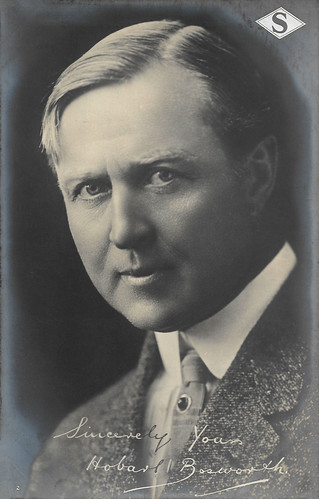
British postcard in the Selig Players Series, no. 2. Photo: Selig Polyscope Co.
Hobart Bosworth (1867-1943) was a pioneering American film director, writer, producer, and actor, who started in 1908 at the Selig Polyscope Company in The Count of Monte Christo (1908) and Dr. Jekyll/Mr. Hyde (1908). Due to his role in pioneering California for the film industry, Bosworth often was referred to as the 'Dean of Hollywood'.

British postcard in the Selig Players Series, no. 3. Photo: Selig Polyscope Co.
Tom Santschi (1878-1931) was an American leading man and character actor of the silent film era. In 1909, he joined The Selig Polyscope Co. of Chicago but soon moved to their new Californian studio in Los Angeles. He gradually mounted from bit player to male lead, acting in dozens of shorts for Selig, along with actors such as Hobart Bosworth and Robert Leonard, and actresses like Kathlyn Williams. With Williams, he starred in the early Selig serial The Adventures of Kathlyn (Francis J. Grandon, 1913). He became famous for his part in the first film adaptation of The Spoilers (Colin Campbell, 1914), in which he staged such a realistic brawl with his opponent William Farnum, that both men afterward suffered severe cuts, contusions, and broken bones.

British postcard in the Selig Player Series, no. 4. Photo: Selig Polyscope Co. Collection: Marlene Pilaete.
Betty Harte (1882–1965) or Bette Hart was an adventurous American leading lady of early silent cinema. She became the first leading lady of the Selig Polyscope Company’s Los Angeles division and appeared in Westerns, period dramas, and Swashbucklers, invariably performing her own stunts. She starred in nine feature films and 108 short films and is credited with writing four screenplays.
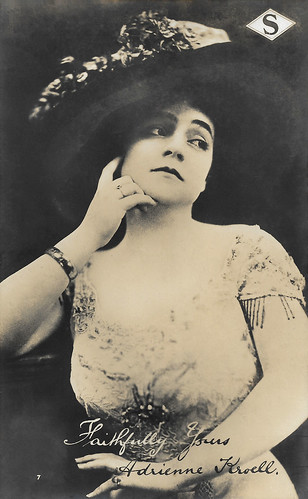
British postcard in the Selig Player Series, no. 7. Photo: Selig Polyscope Co.
American actress Adrienne Kroell (1892-1949) appeared in over 75 to 90 films between 1909 and 1914, mostly for the Selig Polyscope Company. The 'Selig Coquette' was considered one of the most beautiful women in the film business.
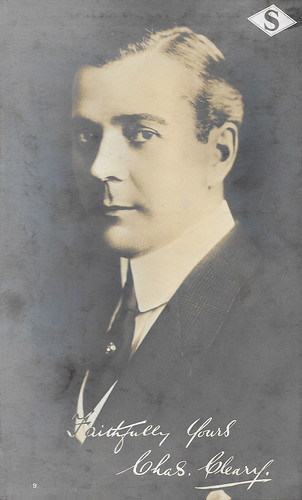
British postcard in the Selig Player Series, no. 9. Photo: Selig Polyscope Co.
Charles Clary (1873-1931) was an American actor of the silent film era. He began his film career in 1910 with the Selig Company in Chicago where he made his film debut in Brown of Harvard (Colin Campbell, 1911) with Edgar G. Wynn. Clary appeared in 206 films between 1910 and 1930.
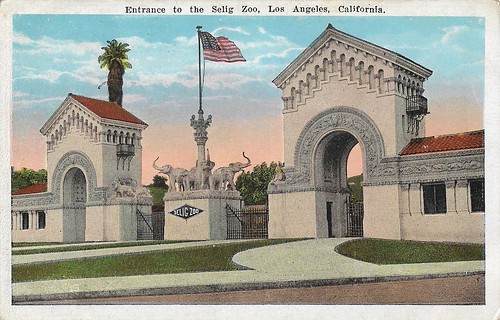
American postcard by California Postcard Co., Los Angeles. The Selig Zoo was constructed in 1915. The zoo’s Mission-style entrance, which featured two large arches and statues of elephants and lions made of Parian marble. Florentine sculptor Carlo Romanelli was the artist responsible for the unique design. Early reports boasted that the zoo entrance alone cost $60,000 to construct.
Legal turmoil over disputes with lawyers representing Thomas Edison
William Selig had worked as a magician and minstrel show operator on the west coast of California. Later on, in Chicago, he entered the film business using his own photographic equipment, free from patent restrictions imposed through companies controlled by Thomas Edison.
In 1896, with help from Union Metal Works and Andrew Schustek, he shot his first film, Tramp and the Dog. He went on to successfully produce local actualities, slapstick comedies, early travelogues, and industrial films. A major client was Armour and Company.
In 1908 Selig Polyscope was involved in the production of 'The Fairylogue and Radio-Plays', a touring 'multimedia' attempt to bring L. Frank Baum's Oz books to a wider public which played to full houses but was nonetheless a financial disaster for Baum.
By 1909 Selig had studios making short features in Chicago and the Edendale district of Los Angeles. The company also distributed stock film footage and titles from other studios. That year, Roscoe 'Fatty' Arbuckle's film debut was a Selig comedy short.
The company's early existence was fraught with legal turmoil over disputes with lawyers representing Thomas Edison's interests. In 1909 Selig and several other studio heads settled with Edison by creating an alliance with the inventor. Effectively a cartel, Motion Picture Patents Company dominated the industry for a few years until the Supreme Court (in 1913 and 1915) ruled the firm was an illegal monopoly.
In 1910 Selig Polyscope produced a wholly new filmed version of The Wonderful Wizard of Oz (Otis Turner, 1910). The company produced the first two-reel film, Damon and Pythias (Otis Turner, 1914), successfully distributed its pictures in Great Britain, and maintained an office in London for several years before World War I. Although Selig Polyscope produced a wide variety of films, the company was most widely known for its wild animal shorts, historical subjects, and early Westerns.

American postcard in the Selig Players series, 1914. Photo: Selig Polyscope Co.
American actress Bessie Eyton (1890-1965) starred in at least 200 melodramas, Westerns, and crime films. She was one of Selig's most popular stars.

American postcard in the Selig Players series. Photo: Selig Polyscope Co.
American child actress Baby Lillian Wade (1907-1990) was one of the stars of the Selig Polyscope Company between 1911 and 1918. She starred in such films as When Lillian Was Little Red Riding Hood (1913) and Little Orphant Annie (1918). Wade appeared in around 60 films for Selig.

American postcard in the Selig Players series. Photo: Selig Polyscope Co.
Stella Razeto (1881-1948) was an American actress of the silent screen, who worked at the companies Selig and Universal, often directed there by her husband Edward LeSaint.
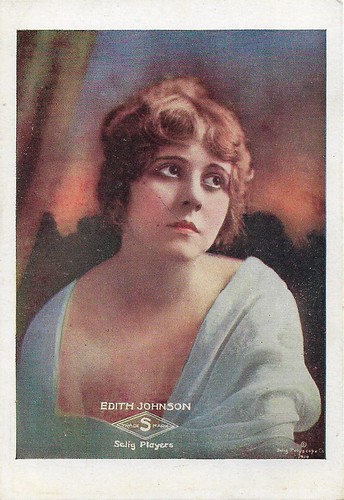
American postcard in the Selig Players series. Photo: Selig Polyscope Co.
Edith Johnson (1894-1969) was an American actress of the silent era. She appeared in 66 films between 1913 and 1924, mostly serials, action films, and Westerns. She and her husband William Duncan were 'the king and queen of the serial'.

American postcard in the Selig Players series. Photo: Selig Polyscope Co.
Kathlyn Williams (1879-1960) was an American actress, known for her blonde beauty and daring antics. She performed on stage as well as in early silent films, in particular at the Selig Polyscope Company in the early 1910s, where she was at first publicised as 'The Selig Girl'. She made history, however, with the very first serial adventure, The Adventures of Kathlyn (1913), which contained a number of wild animals, and it saved the faltering studio from bankruptcy.
Highly successful short films involving wild animals in exotic settings
Attracted by Southern California's mild, dry climate, varied geography for location shooting, and isolation from Edison's legal representatives on the east coast, William Selig set up his studio in Edendale in 1909 with director Francis Boggs, who began the facility in a rented bungalow and quickly expanded, designing the studio's front entrance after Mission San Gabriel.
An early production there was The Count of Monte Cristo (1910). Edendale soon became Selig Polyscope's headquarters, but in 1911 Boggs was murdered by a Japanese gardener who also wounded Selig. The company produced hundreds of short features at Edendale, including many early Westerns featuring Tom Mix which were also shot at Las Vegas, New Mexico.
Selig Polyscope made dozens of highly successful short films involving wild animals in exotic settings, including a popular re-creation of an African safari hunt by Teddy Roosevelt. In 1914 Selig made 14 short experimental "talking pictures" with Scottish actor Harry Lauder.
In 1913, through a collaborative partnership with the Chicago Tribune, Selig produced The Adventures of Kathlyn, introducing a dramatic serial plot device that came to be known as the cliffhanger. Each chapter's story was simultaneously published in the newspaper. A combination of wild animals, clever dramatic action, and Kathlyn Williams' screen presence resulted in significant success. The Tribune’s circulation reportedly increased by 10% and both a dance and a cocktail were named after Williams, whose likeness was reportedly sold on over 50,000 postcards.
With the release of The Spoilers (Colin Campbell, 1914) starring William Farnum and Kathlyn Williams, Selig enjoyed his greatest success. At this point, Selig Polyscope appeared to have a bright future, but things quickly changed. During this time the industry was evolving from producing the short films Selig specialised into modern feature-length productions. While William did make longer films like The Spoilers, he felt shorts were the way of the future. The onset of World War I also hurt Selig Polyscope, given its extensive European operations.
By 1913 Selig had gathered a large collection of animals for his films and spent substantial funds acquiring and developing 32 acres (130,000 m2) of land in Lincoln Heights northeast of downtown Los Angeles, where he opened a large public zoo. In 1915, Selig entered into an agreement with Vitagraph Studios, Lubin Manufacturing Company, and Essanay Studios to form a film distribution partnership known as V-L-S-E, Incorporated. However, the dissolution of the Patents Company made the industry more competitive, dooming the pioneer studios.
World War I cut severely into the substantial revenues Selig Polyscope had been garnering in Europe and the company shunned profitable film industry trends, which had shifted towards dramatic (and more costly) full-length feature films. In 1917 Selig sold the Edendale facility to producer William Fox and moved his movie studio to the zoo in East Los Angeles. Selig Polyscope became insolvent and ceased operations in 1918. Tom Mix signed with Fox back at Edendale and went on to even greater success as a matinée cowboy star.
Film studios rented animals and staged many shoots at the Selig zoo sometimes later claiming they had been filmed in Africa. The first Tarzan of the Apes (Scott Sidney, 1918) with Elmo Lincoln was filmed there. In 1920 Louis B. Mayer rented his first studio space for Mayer Pictures at the site.
Selig planned to develop it into a major tourist attraction, amusement park, and popular resort named Selig Zoo Park with a Ferris wheel, carousels, mechanical rides, an enormous swimming pool with a sandy beach and a wave-making machine, hotel, theatre, cinema, restaurants and thousands of daily visitors, more than 30 years before Disneyland. Only a single carousel was built. Selig Polyscope's extensive collection of props and furnishings were auctioned off at the zoo in 1923.
Selig finally sold the zoo following a flood during the Great Depression. Selig moved into independent production after closing his studios, working infrequently until the 1930s. His glory days were past, though, and he faded into obscurity.
Some of the animals of Selig's zoo were donated to Los Angeles County, forming a substantial addition to Griffith Park Zoo. The property was used as a jalopy racetrack during the 1940s and early 1950s. In 1955 the site was described as "an inactive amusement park."
The carousel survived on the site until 1976 when it was destroyed by fire. The former Selig zoo's arched front gate with its lavish animal sculptures was a crumbling landmark in Lincoln Heights for many decades. By 2003 the sculptures were reportedly being restored for installation at the Los Angeles Zoo and in 2007 tennis courts were on the site.
In the late 1940s, William Selig made a large donation of business records to the Academy of Motion Picture Arts and Sciences Library. The William Selig papers, together with the donation, include Selig's correspondence, scripts, scrapbooks, production files, and six feet of photographs that include production stills from over 500 films that are otherwise lost. Only about 225 of the 3,500 films released by Selig between 1896 and 1938 have survived.
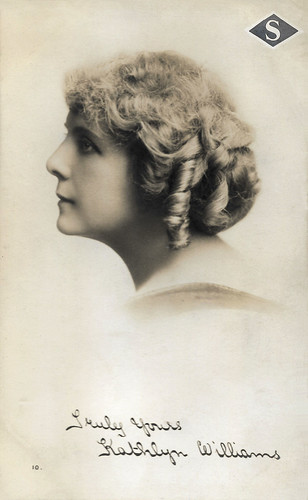
British postcard in the Selig Player Series, no. 10. Photo: Selig Polyscope Co.
Kathlyn Williams (1879-1960) was an American actress, known for her blonde beauty and daring antics. She performed on stage as well as in early silent film, in particular at the company Selig Polyscope in the early 1910s. There she was known as 'the Selig Girl'.

British postcard in the Selig Players Series, no. 11. Photo: Selig Polyscope Co.
American stage and silent-screen actress Mabel Taliaferro (1887-1979) was known as 'the Sweetheart of American Movies'. After a successful stage career, she entered the cinema at Selig in 1911.

British postcard in the Selig Player Series. Photo: Selig Polyscope Co.
Eugenie Besserer (1868-1934) was an American actress who starred in silent films and features of the early sound era. At 42, she made her film debut in Selig's The Wonderful Wizard of Oz (1910), the earliest surviving film version of L. Frank Baum's novel. Her most prominent role is that of Al Jolson's mother in the first talkie, The Jazz Singer (1927).

British postcard in the Selig Player Series. Photo: Selig Polyscope Co.
Herbert Rawlinson (1885-1953) was a British actor who knew a rich career in American silent cinema, and less so in sound films. He made his film debut in 1911 as the male lead Hank Gibson opposite Tom Mix in a supporting part as the sheriff in the short film The Cowboy and the Shrew, produced by Selig Polyscope. Rawlinson became one of Selig's main actors, and had an enormous output of shorts there, already some 33 films in 1911 and some 40 titles in 1912. He alternated starring roles with major supporting parts, opposite such actors as Hobart Bosworth, Tom Santschi, and Sydney Ayres. All in all, he played in some 400 films.
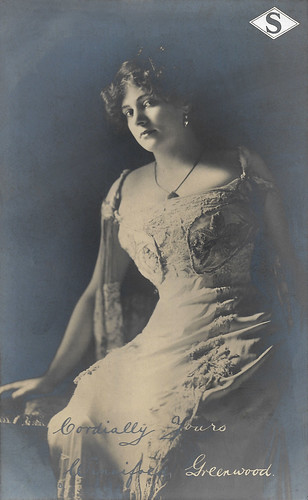
British postcard in the Selig Players Series. Photo: Selig Polyscope Co.
Winifred Greenwood (1885-1961) was an American silent film actress. In 1910, Greenwood was signed by the Selig Polyscope Company. One of her first films was the silent short Brown of Harvard (1911) based on the 1906 play of the same name by Rida Johnson Young. She starred in a number of films with Charlotte Burton including The Shriner's Daughter (1913). She played a child model in The Beggar Child (1914). Often her co-stars were Ed Coxen and her husband George Field, such as in the short comedy-drama Wife Wanted (1915). Between 1910 and 1927, she starred in over 200 films.
Sources: Wikipedia and IMDb.
Check out our earlier Before Hollywood posts: Vitagraph, Essanay, Biograph, Lubin, Flying A, Kalem, and Edison.
No comments:
Post a Comment